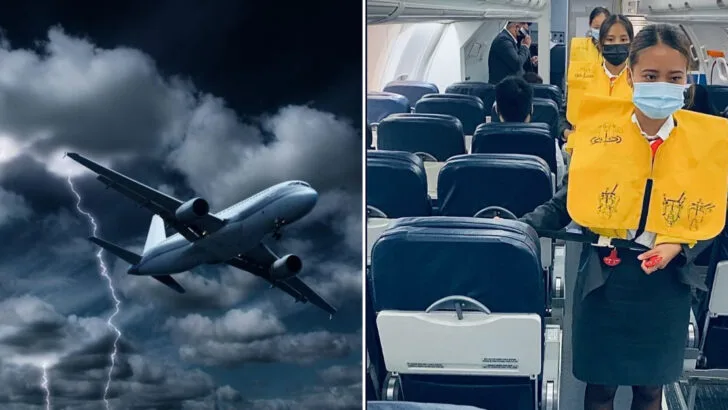Flying is an experience filled with unseen details and intricate systems. From the air we breathe to the wings’ design, there’s more to aviation than meets the eye. Explore these 17 lesser-known facts and gain a newfound appreciation for your next flight.
Cabins Are Pressurized to the Equivalent of a High Altitude
Ever wonder why your ears pop during a flight? Airplane cabins are pressurized to simulate the air pressure found at around 6,000 to 8,000 feet above sea level. This helps passengers breathe comfortably and reduces discomfort.
The pressure levels strike a balance between what is comfortable for passengers and what is feasible for the aircraft’s structure. Although it might feel similar to ground level, there are subtle differences that can affect your body.
Flying at this altitude reduces the risk of altitude sickness while allowing the aircraft to operate efficiently at high altitudes, where the air is thinner.
Humidity Inside Planes Is Very Low
The air inside an airplane is drier than some of the world’s deserts. With humidity levels often below 20%, it can leave your skin and eyes feeling parched. This dry environment is due to the high altitudes where airplanes typically cruise.
Because the outside air is so cold and dry, the cabin must maintain lower humidity to prevent condensation, which could lead to corrosion in the aircraft.
Passengers are encouraged to stay hydrated and may notice that their skin feels tighter or dry after a long flight. Consider applying moisturizer before boarding!
Cabin Air Is Recycled — and Filtered
You might think the air in a plane is stale, but it’s actually carefully managed. Cabin air is recycled every two to three minutes, passing through high-efficiency particulate air (HEPA) filters that remove 99.97% of airborne particles.
This continuous circulation ensures a supply of fresh air mixed with filtered cabin air, making it cleaner than most office buildings.
The filters capture bacteria and viruses, significantly reducing the chances of airborne transmission of illnesses. This system is one reason flying is generally safe from a respiratory health perspective.
Food and Drinks Taste Different at Altitude
Do you notice that airplane food sometimes tastes bland? At high altitudes, our taste buds and sense of smell are altered. The cabin’s low humidity and pressure reduce our ability to taste sweet and salty flavors by up to 30%.
Airlines often adjust their recipes, adding more seasoning to compensate for these changes. Certain dishes, like spicy curries, tend to fare better in-flight.
Even our sense of smell is dulled, which affects how we perceive flavors. Next time you fly, try experimenting with different foods to see what your palate prefers at cruising altitude.
Turbulence Is Usually Uncomfortable but Rarely Dangerous
Turbulence can rattle nerves, but it’s generally not a cause for concern. Turbulence occurs when the plane flies through different air currents, much like a car hitting a bumpy road.
Modern aircraft are built to withstand even severe turbulence, with pilots trained to navigate safely through it. Seatbelt signs are crucial for passenger safety during these times.
While it might feel unsettling, turbulence is a regular part of flying. Trust in the aircraft’s design and the crew’s expertise to manage these moments with ease.
Winglets and Swept Wings Save Fuel
Ever noticed the little tips at the end of airplane wings? They’re called winglets. These extensions, along with swept-back wing designs, play a crucial role in improving fuel efficiency.
By reducing drag, winglets allow airplanes to use less fuel, saving airlines money and reducing environmental impact. This clever design is a product of extensive aerodynamic research.
Swept wings also help planes fly faster and more efficiently at high altitudes. Together, these features contribute to smoother and more eco-friendly flights.
Airplanes Are Designed to Handle Lightning Strikes
Flying through a storm can be intimidating, but modern airplanes are built to withstand lightning strikes. In fact, they are struck about once a year on average without any serious consequences.
The aircraft’s metal skin conducts electricity around the cabin and safely away from passengers and systems, thanks to advanced engineering.
These safety measures ensure that any electrical surge is dissipated efficiently, keeping both the passengers and the plane’s systems secure. So next time you see a flash in the sky, rest easy knowing the plane is well-prepared.
Autopilot Does a Lot — but Pilots Stay in Control
While autopilot is a remarkable tool, pilots remain at the helm, actively managing every flight. Autopilot systems handle routine tasks, like maintaining altitude and speed, allowing pilots to focus on complex situations.
Pilots are trained to intervene whenever there’s a need, ensuring safety and efficiency. They monitor all systems, ready to take full control if conditions demand.
Autopilot is a valuable aid, but the expertise and judgment of pilots are irreplaceable. It’s a teamwork of man and machine that makes flying so reliable and safe.
Flight Times Differ Because of Winds
Have you ever wondered why the same route can take different times on different days? Wind plays a vital role in determining flight duration. Jet streams, fast-flowing air currents high in the atmosphere, can significantly affect flight times.
Flights traveling with the wind may arrive much earlier, while those against it might take longer. This natural phenomenon is intricately planned for by airlines.
Understanding these wind patterns helps pilots choose the most efficient paths, saving fuel and time. Next time you board, remember that the winds are part of the journey’s adventure.
“Black Boxes” Are Rugged and Record More Than You’d Think
The term ‘black box’ is somewhat misleading, as these critical devices are usually bright orange for easy recovery. They record flight data and cockpit conversations, providing vital clues in the event of an accident.
Black boxes are built to withstand extreme conditions, including deep-sea pressures and intense fires. They can record up to 25 hours of data, offering invaluable insights.
These devices are meticulously designed, contributing to safer skies by helping investigators understand what went wrong and how future incidents can be prevented.
Boarding Methods Matter — and Many Are Inefficient
Ever felt the boarding process was chaotic? You’re not alone. Many traditional boarding methods, like back-to-front, are less efficient than alternatives.
Studies and experiments have shown that strategies like the Wilma method, which boards window seats first, can speed up the process significantly.
Airlines continually explore more efficient ways to board passengers, aiming to reduce delays and improve the overall experience. Next time you board, consider the method in use and how it impacts your wait time.
Seat Pitch and Comfort Aren’t the Same as Seat Width
While seat width is often discussed, seat pitch is equally crucial in determining comfort. Seat pitch refers to the space between seats, affecting legroom and overall ease.
Airlines balance seat pitch and width to maximize space and passenger comfort, influenced by aircraft design and class.
Understanding these terms can help you choose a more comfortable seat, particularly on long-haul flights. A few extra inches of pitch can make a noticeable difference in your comfort level.
Most Engine Failures Are Nonfatal and Extremely Rare
The thought of engine failure might be unsettling, but modern planes are designed to handle such situations gracefully. Dual engines allow an aircraft to continue flying safely even if one fails.
Engine failures are incredibly rare, and pilots undergo rigorous training to manage them calmly and effectively. The redundancy in aircraft systems ensures passenger safety.
It’s reassuring to remember that aviation remains one of the safest modes of transport, thanks to these robust safety protocols and the skilled professionals in the cockpit.
Airlines and Regulators Require Routine, Layered Maintenance Checks
Maintenance is a rigorous, ongoing process in the aviation industry. Airlines adhere to strict schedules, performing various checks from simple inspections to comprehensive overhauls.
These checks, mandated by aviation authorities, ensure that every component of the airplane is in optimal condition. From engines to electronics, no detail is overlooked.
This layered approach to maintenance is a cornerstone of aviation safety, ensuring that each flight is as secure and reliable as possible. It’s a testament to the industry’s commitment to passenger welfare.
Cargo Holds on Many Passenger Jets Are Pressurized and Temperature-Controlled
Many travelers are surprised to learn that cargo holds in passenger jets are often pressurized and temperature-controlled. This ensures that items like pets, plants, and sensitive equipment are kept safe during the flight.
The conditions mimic the cabin environment, allowing for the safe transport of various goods. It’s not just passengers who travel in comfort!
Understanding this feature can provide peace of mind, especially for those shipping valuable or delicate items. It’s another example of the thoughtful engineering behind modern air travel.
Safety Demonstrations Are Required Even for Repeat Flyers
Even if you’ve flown many times, safety demonstrations are a must. Regulations require that every passenger is briefed before takeoff, regardless of prior experience.
These briefings ensure everyone is familiar with the specific aircraft’s emergency procedures and equipment locations.
While it may seem routine, paying attention can make a difference in an emergency. It’s a simple yet vital part of every flight, reinforcing safety for all onboard.
Simple Habits Cut Jet Lag and Improve Comfort
Jet lag can be a nuisance, but simple habits can alleviate its effects. Staying hydrated, adjusting your sleep schedule before travel, and getting sunlight upon arrival can help reset your internal clock.
Comfort on long flights is enhanced by wearing loose clothing, using a neck pillow, and moving around when possible.
These small adjustments can make a significant difference in your travel experience, allowing you to arrive at your destination feeling refreshed and ready to explore. Embrace these habits for a smoother journey.

